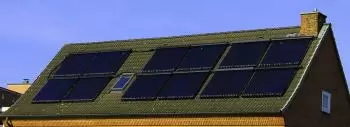
A forced circulation solar system is a solar thermal installation in which water circulates within the circuit driven by a pump.
Unlike solar installations with a thermosiphon, this system does not move hot water to the highest point of the closed circuit, but rather makes it go down from the solar collectors to where the storage tank is located.
In many cases it is not feasible to install solar thermal energy equipment to obtain domestic hot water by thermosyphon, given that the location of the solar collectors is often above the tank.
This renewable energy system is required in underfloor heating systems.
In these solar thermal systems, the water that circulates between the solar collectors and the accumulator cannot do so by natural convection since the hottest water is already at its highest point. To do this, you will need a conventional water pump and, therefore, an external electrical power source.
Forced systems are always indirect, except for pool air conditioning uses where the pool's water filtering drive system itself can be used.
By using an external energy source, this form of solar energy harvesting can no longer be considered a passive solar energy system.
Advantages of the forced circulation system
The advantages of forced circulation solar systems are:
- The structure of the house does not determine its location. The hot water tank can be inside the building and outside it will only be necessary to install the solar panels.
- Better battery protection: The possibility of placing the battery inside the home allows you to install a larger battery, it is better insulated. By not being exposed to the weather, its durability will improve.
- Better thermal efficiency: the thermal efficiency for heating water is greater than in the solar thermal system with thermosyphon because by being able to regulate the speed of the water that circulates through the solar collector, it can be optimized to obtain the highest thermal performance in accordance with the laws of thermodynamics.
Disadvantages of the forced circulation system
On the other hand, forced circulation systems imply certain drawbacks:
- The system requires the installation of a water pump to allow water circulation. The presence of the pump implies an increase in maintenance costs since there are more elements with the possibility of suffering breakdowns.
- Need to have an electricity point to be able to use electrical energy.
- The overall energy efficiency is lower than with the thermosiphon system. Although the thermal efficiency is higher, the electricity consumption for the operation of the water pump must be added.
Basic elements of a solar system with forced circulation
Solar thermal energy installations with forced circulation have the following elements:
Solar collectors
Solar collectors are responsible for transforming solar radiation into thermal energy. Since in these assemblies the circulation of the fluid through the collector is forced, the pressure losses (resistance to the passage of water) are not an important limitation in terms of their value, since they can be compensated when choosing the pump. of water. What will be vital is knowing the pressure losses of selecting the optimal circulator pump.
In forced circulation installations, vertical and/or horizontal solar collectors can be used interchangeably depending on integration criteria, although vertical ones have better performance.
Hot current accumulator
The accumulator is a tank where heated water is stored. This type of assembly allows several variants to be used regarding the accumulator, given that the circulator will pass the water through the heat exchanger it incorporates.
Differential thermostat
Differential thermostats control the pump so that it only pumps water at times when there may be energy gain. Avoiding energy waste at night or when the solar radiation received is insufficient.
The differential thermostat continuously compares the temperatures of the collector and the accumulator, connecting or disconnecting the pump depending on which temperature is higher.
Security elements
To protect the solar collector from overpressure, it is mandatory to install a safety valve in each group or row of solar panels.
On the other hand, the primary circuit will be equipped with a security group that will consist of at least:
- an expansion vessel
- a safety valve
- a manometer.
Likewise, these installations will incorporate active protection systems against low temperatures (frost) or high temperatures (overheating).
Circulation group
The circulation group allows the circulation of fluid through the circuit, generally it is a pump.
The circulation group is generally located at the bottom of the accumulator (cold water inlet), towards the bottom of the collectors. In addition, you will have the following elements:
- Electromechanical circulator for closed circuits, of the type used in heating circuits.
- Non-return valve, to avoid uncontrolled reverse circulation.
- Flow regulator, which will allow the circuit flow to be adjusted.
- Filter, which will guarantee the durability of the circuit elements.